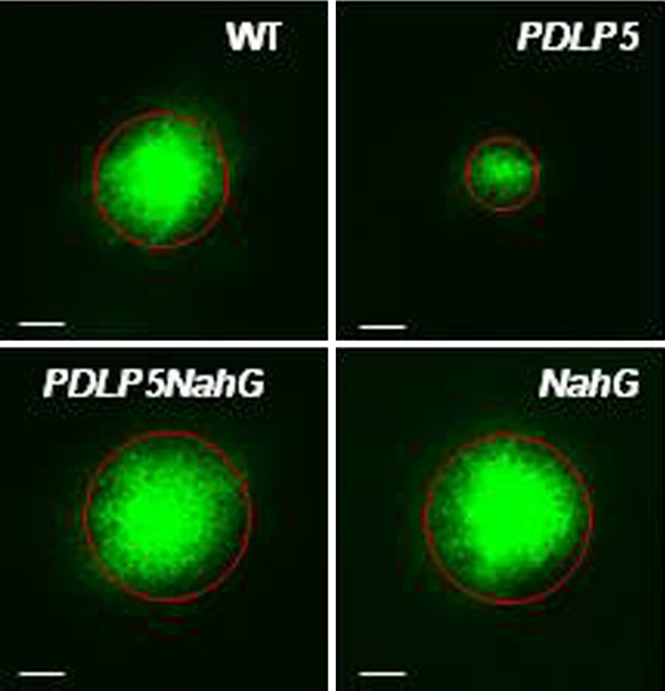Plasmodesmata (PD) are microscopic channels that allow communication and transport to occur between cells (reviewed in Lee and Lu, 2011). PD are structurally complex, dynamic structures that adjust to the needs of the plant. For example, when a plant is attacked by a microbe, the PD of the diseased cells close, preventing toxic materials from spreading throughout the plant. Plants close or restrict their PD openings by sealing them with layers of callose, a β-1,3 glucan polymer. While this strategy leads to localized cell death, it allows the sessile plant to survive a microbial onslaught. This process requires well-coordinated cell-to-cell signaling; although the infection is confined to the tissue that undergoes cell death, systemic immune signals are spread throughout the plant. The plant immune response requires salicylic acid (SA), which functions as an immune signal by regulating cell death, activating the expression of various pathogenesis-related genes, and inducing resistance to virulent microbes. SA is clearly vital for disease resistance in plants, but until recently, it was not known whether this hormone also affects the closure of PD.
In a series of elegant experiments, Wang et al. (pages 2315–2329) show that SA and its signaling pathway regulate the closure of PD in Arabidopsis thaliana plants under pathogen attack. The authors used the Drop-and-See (DANS) assay to assess the diffusion of the membrane-permeable, non-fluorescent probe carboxyfluorescein diacetate through the PD. This probe acquires fluorescence upon release into the cytoplasm and becomes membrane impermeable, making it an excellent marker for diffusion through the PD. Using this assay, the authors determined that exogenous application of SA induces PD closure. They then examined the effects of SA on plants overexpressing plasmodesmata-located protein5 (PDLP5). PDLP5, which is induced by SA application and bacterial infection, induces PD closure (Lee et al., 2011). The PDLP5-overexpressing plants, which are known to exhibit SA hyperaccumulation and enhanced basal immunity, exhibited increased PD closure, showing decreased dye diffusion in the DANS assay. The authors genetically suppressed SA hyperaccumulation in these plants by introducing NahG, which encodes a bacterial SA hydroxylase that disables SA accumulation. Indeed, the hyperaccumulation of SA in PDLP5-overexpressing plants was negated by NahG, leading to increased dye diffusion in the PDLP5NahG plants, which even exceeded wild-type levels (see figure). Therefore, SA acts as a signal to induce PD closure, and SA is required for PDLP5-mediated PD closure. In addition, NahG plants failed to close their PD in response to bacterial infection due to their inability to accumulate SA. This response was also impaired in the PDLP5NahG plants, reinforcing the notion that SA build-up is required for both the regulation of PD and basal immunity in PDLP5 plants. Importantly, the authors also demonstrate that PDLP5 is required for callose deposition in the PD in response to exogenous SA, as wild-type plants accumulated callose in response to SA treatment, while pdlp5 mutants did not. By studying other SA mutants using the DANS assay, the authors also demonstrate that NONEXPRESSOR OF PATHOGENESIS-RELATED GENES1 (NPR1), a master regulator of SA signal transduction, works in tandem with PDLP5 to close PD via increased PD-callose deposition.
Confocal images showing carboxyfluorescein diacetate movement through PD in leaf abaxial surfaces using the DANS assay. Red circles represent the extent of dye diffusion. Bars = 200 μm. (Reprinted from Wang et al. [2013], Figure 1B.)
Therefore, SA indeed causes callose buildup in PD. Without either PDLP5 or NPR1, however, Arabidopsis plants cannot close their PD in response to pathogen attack, and the disease spreads throughout the plant.
References
- Lee J.Y., Lu H. (2011). Plasmodesmata: The battleground against intruders. Trends Plant Sci. 16: 201–210 [DOI] [PubMed] [Google Scholar]
- Lee J.Y., Wang X., Cui W., Sager R., Modla S., Czymmek K., Zybaliov B., van Wijk K., Zhang C., Lu H., Lakshmanan V. (2011). A plasmodesmata-localized protein mediates crosstalk between cell-to-cell communication and innate immunity in Arabidopsis. Plant Cell 23: 3353–3373 [DOI] [PMC free article] [PubMed] [Google Scholar]
- Wang X., Sager R., Chi W., Zhang C., Lu H., Lee J.Y. (2013). Salicylic acid regulates plasmodesmata closure during innate immune responses in Arabidopsis. Plant Cell 25: 2315–2329 [DOI] [PMC free article] [PubMed] [Google Scholar]



